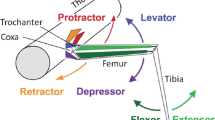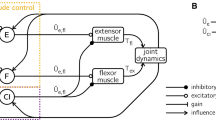Abstract
Recent experiments, reported in the accompanying paper, have supplied key data on the impact afferent excitation has on the activity of the levator–depressor motor system of an extremity in the stick insect. The main finding was that, stimulation of the campaniform sensillae of the partially amputated middle leg in an animal where all other but one front leg had been removed, had a dominating effect over that of the stepping ipsilateral front leg. In fact, the latter effect was minute compared to the former. In this article, we propose a local network that involves the neuronal part of the levator–depressor motor system and use it to elucidate the mechanisms that underlie the generation of neuronal activity in the experiments. In particular, we show that by appropriately modulating the activity in the neurons of the central pattern generator of the levator–depressor motor system, we obtain activity patterns of the motoneurons in the model that closely resemble those found in extracellular recordings in the stick insect. In addition, our model predicts specific properties of these records which depend on the stimuli applied to the stick insect leg. We also discuss our results on the segmental mechanisms in the context of inter-segmental coordination.
Similar content being viewed by others
References
Akay T, Haehn S, Schmitz J, Büschges A (2004) Signals from load sensors underlie interjoint coordination during stepping movements of the stick insect leg. J Neurophysiol 92: 42–51
Bässler U (1993) The walking- (and searching-) pattern generator of stick insects, a modular system composed of reflex chains and endogenous oscillators. Biol Cybern 69: 305–317
Borgmann A, Scharstein H, Büschges A (2007) Intersegmental coordination: influence of a single walking leg on the neighboring segments in the stick insect walking system. J Neurophysiol 98: 1685–1696
Borgmann A, Hooper SL, Büschges A (2009) Sensory feedback induced by front-leg stepping entrains the activity of central pattern generators in caudal segments of the stick insect walking system. J Neurosci 29: 2972–2983
Borgmann A, Toth TI, Gruhn M, Büschges A, Daun-Gruhn S (2012) Dominance of local sensory signals over inter-segmental effects in a motor system—experiments. Biol Cybern. doi:10.1007/s00422-012-0473-y
Büschges A (2005) Sensory control and organization of neural networks mediating coordination of multisegmented organs for locomotion. J Neurophysiol 93: 1127–1153
Büschges A, Gruhn M (2008) Mechanosensory feedback in walking: from joint control to locomotor patterns. Adv Insect Physiol 34: 193–230
Daun S, Rybak IA, Rubin J (2009) The response of a half-center oscillator to external drive depends on the intrinsic dynamics of its components: a mechanistic analysis. J comput Neurosci 27: 3–36
Daun-Gruhn S (2011) A mathematical modeling study of inter-segmental coordination during stick insect walking. J Comput Neurosci 30: 255–278
Daun-Gruhn S, Büschges A (2011) From neuron to behavior—dynamic equation-based prediction of biological processes in motor control. Biol Cybern 105:71–88. doi:10.1007/s00422-011-0446-6
Daun-Gruhn S, Toth TI (2011) An inter-segmental network model and its use in elucidating gait-switches in the stick insect. J comput Neurosci 31(1): 43–60. doi:10.1007/s10827-010-0300-1
Ekeberg O, Blümel M, Büschges A (2004) Dynamic simulation of insect walking. Athropod Struct Dev 33: 287–300
El Manira A, DiCaprio RA, Cattaert D, Clarac F (1991) Monosynaptic interjoint reflexes and their central modulation during fictive locomotion in crayfish. Eur J Neurosci 3: 1219–1231
Gabriel JP, Scharstein H, Schmidt J, Schmidt J (2003) Control of flexor motoneuron activity during single leg walking of the stick insect on an electronically controlled treadwheel. J Neurobiol 56: 237–251
Gossard JP, Cabelguen JM, Rossignol S (1990) Phase-dependent modulation of primary afferent depolarization in single cutaneous primary afferents evoked by peripheral stimulation during fictive locomotion in the cat. Brain Res 537: 14–23
Graham D (1972) A behavioural analysis of the temporal organisation of walking movements in the 1st instar and adult stick insect (Carausius morosus). J Comp Physiol 81: 23–52
Hodgkin AL, Huxley AF (1952) A quantitative description of membrane current and its application to conduction and excitation in nerve. J Physiol 117: 500–544
Laurent G, Burrows M (1989) Distribution of intersegmental inputs to nonspiking local interneurons and motor neurons in the locust. J Neurosci 9: 3019–3029
Laurent G, Burrows M (1989) Intersegmental interneurons can control the gain of reflexes in adjacent segments of the locust by their action on nonspiking local interneurons. J Neurosci 9: 3030–3039
Ludwar BC, Westmark S, Büschges A, Schmidt J (2005) Modulation of membrane potential in mesothoracic moto- and interneurons during stick insect front leg walking. J Neurophysiol 93: 1255–1265
Schmidt J, Fischer H, Büschges A (2001) Pattern generation for walking and searching movements of a stick insect leg. II. Control of motoneuronal activity. J Neurophysiol 85: 354–361
Schmitz J (1993) Load-compensating reactions in the proximal leg joints of stick insects during standing and walking. J Exp Biol 183: 15–33
Traub RD, Wong RKS, Miles R, Michelson H (1991) A model of a CA3 hippocampal pyramidal neuron incorporating voltage-clamp data on intrinsic conductances. J Neurophysiol 66: 635–650
Wolf H, Burrows M (1995) Proprioceptive sensory neurons of a locust leg receive rhythmic presynaptic inhibition during walking. J Neurosci 15: 5623–5636
Zill SN, Schmitz J, Büschges A (2004) Load sensing and control of posture and locomotion. Athropod Struct Dev 33: 273–286
Zill SN, Keller BR, Duke ER (2009) Sensory signals of unloading in one leg follow stance onset in another leg: transfer of load and emergent coordination in cockroach walking. J Neurophysiol 101: 297–304
Author information
Authors and Affiliations
Corresponding author
Rights and permissions
About this article
Cite this article
Daun-Gruhn, S., Tóth, T.I. & Borgmann, A. Dominance of local sensory signals over inter-segmental effects in a motor system: modeling studies. Biol Cybern 105, 413–426 (2011). https://doi.org/10.1007/s00422-012-0474-x
Received:
Accepted:
Published:
Issue Date:
DOI: https://doi.org/10.1007/s00422-012-0474-x




